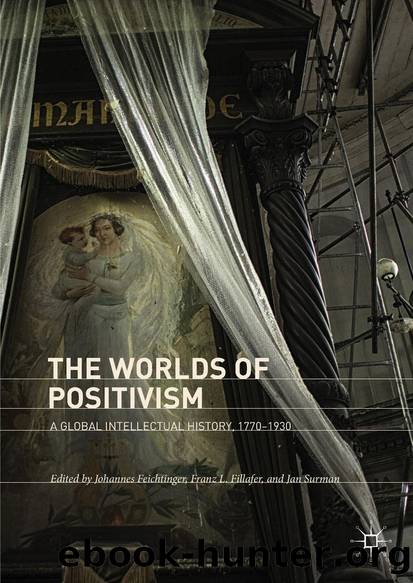The Worlds of Positivism by Johannes Feichtinger

Author:Johannes Feichtinger
Language: eng
Format: epub
Publisher: Springer International Publishing
For Renan , the sciences and the universe were part of one large-scale cosmological development which he portrayed in âLes sciences de la nature et les sciences historiquesâ. A primitive âatomic periodâ was succeeded by a molecular era when atoms combined, then a solar period when stars were formed, a planetary era when systems were created around the stars, a period of individual development for each planet when the earth took its current form. It was followed by a period of unconscious, biological humanity , which saw the progressive emergence of consciousness and whose appearance marked the beginning of the final period, that of historical time. 132 A specific type of science corresponded to each period: astronomy and, more recently, geology thus explained the history of the cosmos and the earth; the biological sciences shed light upon the physical appearance of man. All that was left was to discover the laws of the historical period. Their discovery would constitute, Renan asserted, âthe highest degree of intellectual cultureâ; this would make it possible to fully âunderstand humanity .â 133
Scrutinizing the regularities in human evolution, Renan built a philosophy of history . Like Comte, he described states characterized by forms of knowledge. But he developed his own formulation of human becoming, substituting the succession of syncretism, analysis, and synthesis for the Comtean sequence of theological, metaphysical, and positive ages. Renanâs states did not correspond to Comteâs three stages. He did not discern a metaphysical age; neither did he claim that the current era would achieve the ultimate step in the development of knowledge and human progress. The current time, that of analysis, certainly shared common traits with the positive age, but it, too, was to be surpassed. Finally, Renan criticized the overly chronological character of Comteâs law of three stages . Syncretism , analysis, and synthesis were not exactly eras of human history, but overlapping, superimposed ways of thinking, which always contained the possibility of reversal.
Other fundamental differences, concerning the place given to reason and the classification of the sciences, were clarified in articles written between 1858 and 1863. The author of Vie de Jésus did not subscribe to what he regarded as Comteâs radical rationalism: âthis analytical, dry, negative arrogance, incapable of understanding things of the heart and the imagination.â 134 Indeed, for Renan science did not hold a monopoly on knowledge: next to what could be studied experimentally, there existed âeverything which is beyond and can be felt, noticed, and revealed but is not demonstrated.â 135 This distinction between reason and sentiment coincided with the juxtaposition of physical and moral phenomena, creating a fundamental rift between two separate orders of sciences, âthe natural sciences and the human sciences.â 136 And, according to Renan , that was precisely what Auguste Comte had not understood in his linear classification: âPreoccupied especially with the method of physical sciences and aspiring to transport this method into other branches of human knowledge,â he had defined the science of man in a rudimentary, restricted manner, as a simple prolongation of the natural sciences.
Download
This site does not store any files on its server. We only index and link to content provided by other sites. Please contact the content providers to delete copyright contents if any and email us, we'll remove relevant links or contents immediately.
Room 212 by Kate Stewart(5041)
The Crown by Robert Lacey(4731)
Endurance: Shackleton's Incredible Voyage by Alfred Lansing(4683)
The Iron Duke by The Iron Duke(4293)
The Rape of Nanking by Iris Chang(4139)
Joan of Arc by Mary Gordon(4017)
Killing England by Bill O'Reilly(3953)
Say Nothing by Patrick Radden Keefe(3903)
I'll Give You the Sun by Jandy Nelson(3359)
Shadow of Night by Deborah Harkness(3307)
Hitler's Monsters by Eric Kurlander(3269)
Mary, Queen of Scots, and the Murder of Lord Darnley by Alison Weir(3152)
Blood and Sand by Alex Von Tunzelmann(3140)
Darkest Hour by Anthony McCarten(3072)
Eleanor & Park by Rainbow Rowell(3063)
Margaret Thatcher: The Autobiography by Thatcher Margaret(3029)
Red Famine: Stalin's War on Ukraine by Anne Applebaum(2874)
Book of Life by Deborah Harkness(2869)
The One Memory of Flora Banks by Emily Barr(2803)
